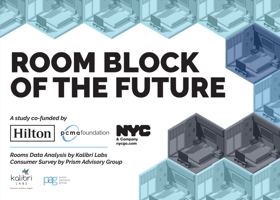Blog
Visual Design Trends and Their Influence on the Hospitality Industry
In the current dynamic landscape of the hospitality industry, the integration of data science innovations is revolutionizing guest experiences and revenue strategies. This evolution extends beyond traditional hospitality environments to encompass innovative platforms like Kalibri Labs, where data-driven decisions are critical to success. In this exploration, we'll delve into how the biggest visual design trends of 2024 intersect with data science, driving personalized experiences and optimizing revenue.
Utilizing Strategic Color Theory:
The cognitive psychology of colors is a cornerstone of design, so having a strategy when selecting colors is important to evoke desired emotions and behaviors. In this era of personalized experiences, it is essential to understand the psychological impact of color on guest perception. For example, take advantage of warm colors to evoke feelings of warmth, energy, and closeness; while cooler tones such as blue and green promote relaxation, tranquility, and security.
Additionally, data analytics can inform color choices that align with brand identity and user preferences, ensuring consistency across all touchpoints. For example, while blue traditionally signifies trust and confidence, Kalibri Labs strategically combines such hues with burgundy tones to embody the vibrancy of the brand and reinforce confidence in the accuracy of the data. This fusion of design and data ensures a consistent user experience, fostering trust and engagement.
Typography Selection and Accessibility:
The proper choice of typography plays a crucial role in the readability and accessibility of a design. Opting for open-source fonts not only provides us with a wide range of stylistic options but also avoids licensing issues and ensures optimal viewing on most devices. This practice significantly improves accessibility by ensuring that users can read content without difficulty, regardless of the device or platform they use. By prioritizing accessibility in design, we not only create a more inclusive experience for all users but also ensure greater effectiveness in communicating our brand or message. Choosing simple typography is important to improve our understanding of what we want to convey. In Kalibri Labs, being a product rich with data, it was also necessary to analyze the visualization of numbers to avoid unnecessarily complicating a central factor of our product.
Minimalist Design for Functionality and Aesthetic Clarity:
Minimalist design principles are gaining momentum driven by the pursuit of functional elegance and streamlined user interfaces. It is proven that eliminating repetitive and/or superfluous elements and focusing on essential components improves usability and aesthetic clarity. Whether designing elegant digital interfaces or optimizing physical spaces, minimalism encourages tranquility, sophistication, and understanding. By prioritizing simplicity and intuitive design, the platforms enable users to navigate complex data landscapes with ease, facilitating informed decision-making and operational efficiency.
Data Visualization for Actionable Insights:
In the era of data-driven decision-making, effective data visualization is critical to gaining actionable insights and driving business success. Hospitality platforms leverage data visualization techniques to synthesize complex data sets into digestible formats, allowing users to gain insights at a glance. By strategically prioritizing data elements and employing intuitive visualization tools, platforms like Kalibri Labs enable users to make informed decisions quickly, optimizing revenue management strategies and improving overall business performance. Additionally, continuous data collection and analysis ensures insights remain relevant and actionable in an ever-changing landscape.
Data Collection:
The way we collect data can provide valuable information about guest preferences and behavior, empowering hospitality companies to make informed decisions that optimize revenue streams and improve guest satisfaction. Active listening is important at each stage to understand how our users engage with the solution provided by us. We can leave a channel of communication always open, organize monthly meetings to receive feedback, or even conduct focus groups. Whatever strategy the company selects, the 2024 trends have made it clear that the user is becoming increasingly influential, so it is important to give them relevance to maintain the loyalty we seek.

Inclusive Design and Personalization:
Inclusion and personalization are key trends for 2024. By embracing diverse perspectives and addressing the unique needs of all guests, companies can create inclusive environments that foster a sense of belonging and comfort. Additionally, the trend toward personalized experiences extends beyond physical spaces to encompass digital interactions, with AI-powered technologies enabling personalized recommendations and seamless service delivery. By prioritizing inclusivity and personalization, platforms can differentiate themselves in a competitive market, driving guest satisfaction and loyalty and maximizing revenue potential.
In conclusion, visual design trends in 2024 mark a clear shift towards user-centered products, where user satisfaction is key to differentiation in a competitive market while encouraging loyalty and promotion. It is important to accept change and meet the expectations of our clients. In 2024, it will become more evident that users are not simply customers, but often determine product features, assertively adapting them to industry needs. That is why maintaining dialogue with customers through different channels is necessary to ensure its correct functioning and thus contribute our grain of sand, helping, in our case, to improve the user experience, providing intuitive products, improving the time invested in extracting actionable keys and thus maximize the performance of our clients.




